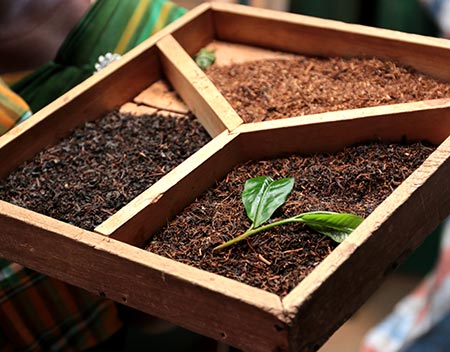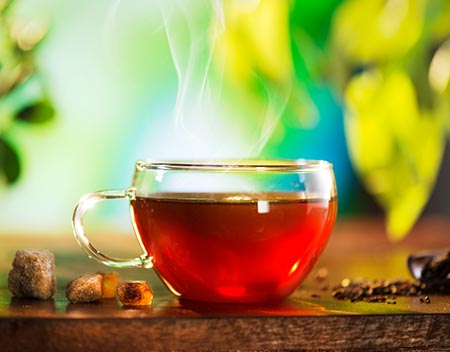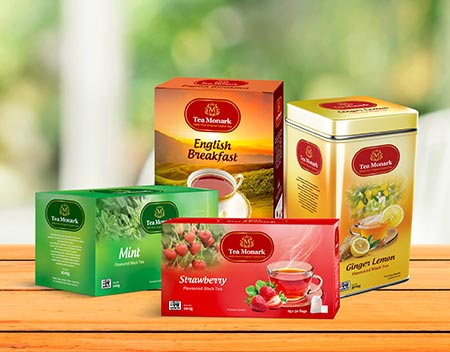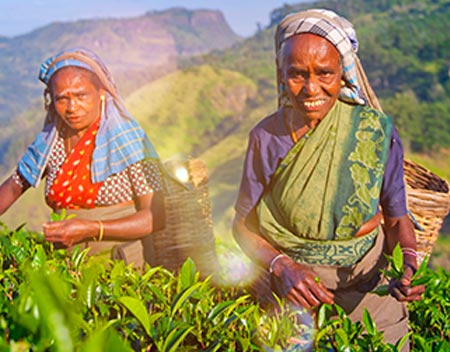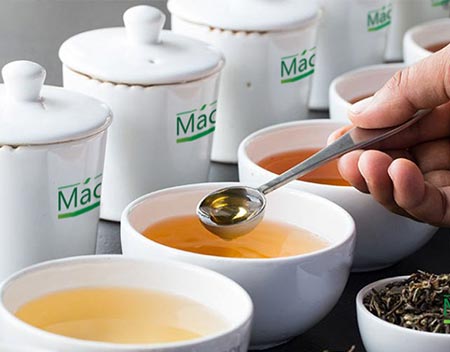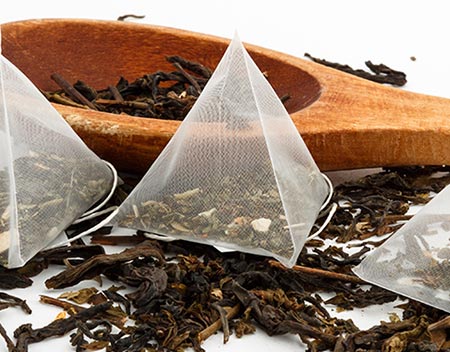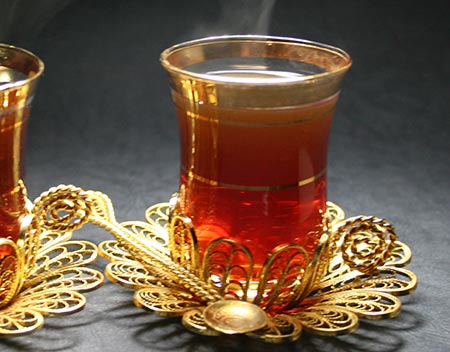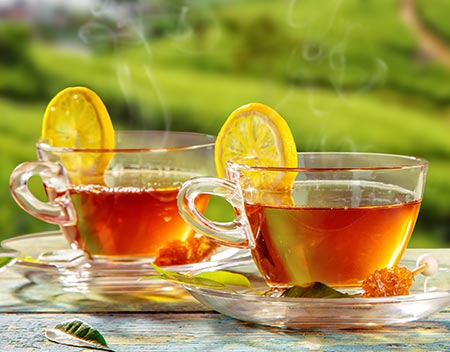
The tea-growing regions of Sri Lanka
The tea-growing regions of Sri Lanka are clustered mostly among the mountains of the island’s central massif and its southern foothils. Once thickly forested and largely inaccessible to humans, the central mountains were known to the ancient Sinhalese as Mayarata, the Country of Illusions. It was said to be haunted by demons and spirits. This fearsome reputation, together with more tangible threats posed by wild beasts, venomous snakes, landslides, rockfalls and the ever-present danger of simply losing one’s way in the forest, kept most people away from the high hills. Settlement was almost nonexistent except in the valleys and around the city of Kandy. Only foresters, hermits and fugitives had any reason to enter the Mayarata.
Thus it was that after the annexation of the Kandyan kingdom in 1815, the British found themselves in possession of vast tracts of virgin montaine forest. Imperial enterprise soon found a way of putting the acquisition to good use. By 1840, there were already about two hundred coffee-estates dotted about the hills; then came a boom in coffee on the London market, fuelling a land-rush. Down came the high forests, acre after acre, to be replaced by endless, regimented rows of coffee-bushes. At the peak of the coffee enterprise in 1878, no less than 113,000 ha. (278,000 acres) were under cultivation.
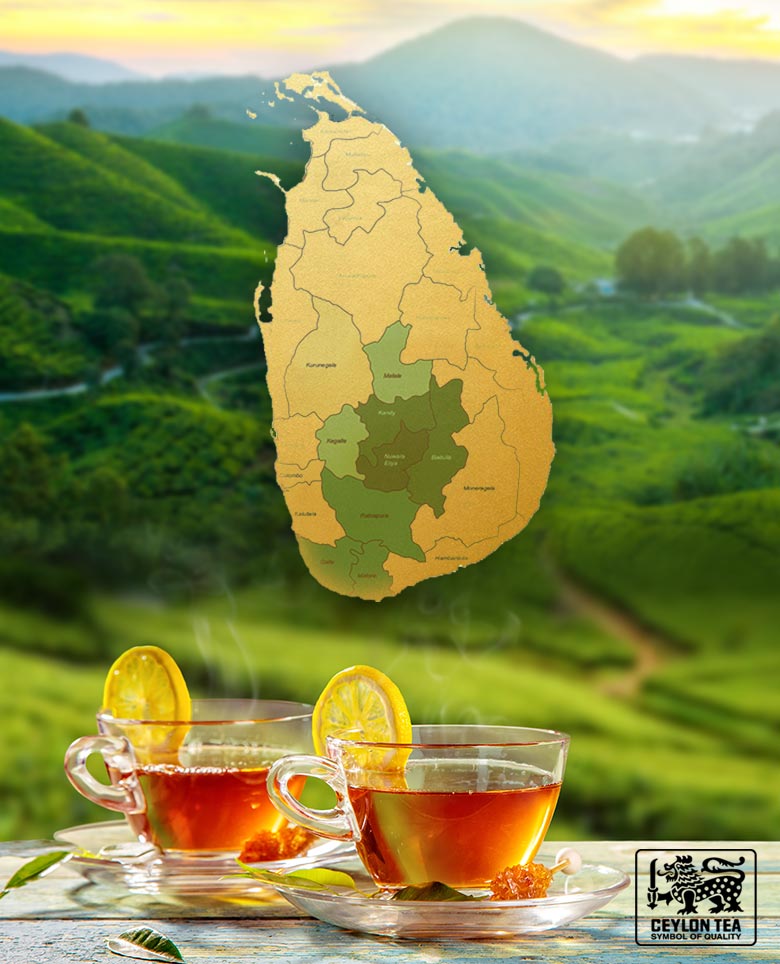
Capturing the essence of
PURE CEYLON TEA
TYPES OF TEA
The district can boast of the origin of the plantation industry in Sri Lanka, firstly Coffee and thereafter Tea. The plantations are spread out from elevation of 2000 – 4000ft above sea level and falls within the Mid Grown Elevation Category. The product is of a full bodied, coloury and strong tea.
The sub districts are Pussellawa / Hewaheta and Matale which includes plantations in Madulkelle, Knuckles and Rangala mountain range.
Nuwara Eliya is a plateau at an elevation of 6240ft above sea level. The cold weather and freshness of the air always scented with the fragrance of cypress that grows in abundance in the area no doubt helps in producing a tea that is sought after by connoisseurs of tea world over. The tea itself is light in cup with exquisite flavour and aroma.
Uda Pussellawa mountain range rise up from the boundary of Uva Districtat the lower end and joins up to Nuwara Eliya Planting District at highest point. It receives the North East Monsoon rains as in the Uva District but does not produce teas of same quality and flavour as in the Uva.
The estates closer to the Nuwara Eliya benefit from the cold weather conditions and is famous for producing a tea with “Rosy Liquor”.
The sub districts are Maturata and Ragala / Halgran Oya.Uva Agro Climaticc Plantingdistrictct is situated in eastern slopes of the central hills of Sri Lanka and tea is grown from 3000 to 5000ft above mean sea level. The district is famous for its distinctive flavour and pungency during the Quality season form July to September each year which are sought after by the connoisseurs of tea world over.
The sub districts are Malwatte / Welimada -well known world over for the teas of pungent character produced during the quality season, Demodara/ Hali Ela/ Badulla - which is more into the central Uva District with the capital being at Badulla. Passara / Lunugala, Madulsima, Ella/ Namunukula - situated on the slopes of Naminukula mountain range which is the tallest mountain in Uva, Bandarawela / Poonagalla, Haputale - situated at the edge of the central hills and Koslanda / Haldummulla situated at the foothills of the central hills.
This agro climatic districtt is the most famous name inCeylonon Tea and is considered the prime planting district in Sri Lanka. The district covers an extensive area from around 3500ft to 5000ft above sea level in the western slopes of the country. The mountains and the valleys extend from Bogawantalwa and Maskeliya bordering the Adams Peak wilderness , to Hatton,Dickoya and Talawakelle, Nanuoya up too the western boundary of Nuwara Eliya. It also extend up to Agrapatana bordering the Horton Planes.
The district receives the south western monsoonal rains which has an impact on the quality of the Dimbula Tea , the cold nights and dry weather from January to March bring about a rage of teas from full bodied to light delicate flavor in different valleys.
The sub district which falls within the Dimbula Agro Climatic District are Hatton / Dickoya, Bogawantalwa - also known as the “Golden Valley”, Upcot / Maskeliya -which is at the foothills of sacred Adams Peak Mountain, Patana/ Kotagala, Nanu oya / Talawakelle, Agrapatana - situated more towards the eastern range, Punadaluu Oya, Ramboda - famous for the breathtaking water falls.
Sabaragamuwa is Sri Lanka’s biggest district, the teas of which are low-grown as its estates range in elevation from sea level to 610m. Sabaragamuwa, sandwiched between Sinharaja in the south and Adam's Peak wilderness in the north, produces a fast-growing bush with a long leaf. The liquor, too, is similar to that of Ruhuna teas, dark yellow-brown with a reddish tint. The aroma, however, is noticeably different from the Ruhuna products, with a hint of sweet caramel, not quite as strong: yet exceptionally stylish.
Tea grows from almost form the sea level to around 2000ft above, and is considered as low grown elevation category.
The uniqueness of the tea is the blackness as well as the strength and character in the cup with stylish range of leafy teas.
The district is in the midst of the national heritage forest reservee “Sinharaja” a congenial atmosphere is created by this forest reserve for the plantations bordering thereserve.
The region mainly receives South West Monsoon rains, the tea bushes thrive in the warm weather conditions and the fertile soils of the district.
The sub districts are Ratnapura/ Balangoda – This sub district is well pprotectedby the Sinharaja forest reserve form the strong winds that accompany South West Monsoon rains.



